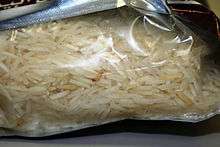Khapra beetle
| Khapra beetle | |
|---|---|
 | |
| Adult Khapra beetle | |
 | |
| Larvae of Trogoderma granarium | |
| Scientific classification | |
| Kingdom: | Animalia |
| Phylum: | Arthropoda |
| Class: | Insecta |
| Order: | Coleoptera |
| Family: | Dermestidae |
| Genus: | Trogoderma |
| Species: | T. granarium |
| Binomial name | |
| Trogoderma granarium Everts, 1898 | |
The Khapra beetle (Trogoderma granarium), also called cabinet beetle,[1] which originated in South Asia, is one of the world’s most destructive pests of grain products and seeds.[2] It is considered one of the 100 worst invasive species in the world.[3] Infestations are difficult to control because of the insect's ability to survive without food for long periods, its preference for dry conditions and low-moisture food, and its resistance to many insecticides.[3] There is a federal quarantine restricting the importation of rice into the U.S,. from countries with known infestations of the beetle.[4]
Description of the insect
Adult beetles are brownish and 1.6–3 mm long. Immature larvae are up to 5 millimeters long and are covered in dense, reddish-brown hair. The eggs of the khapra beetle are cylindrical with one end more rounded and the other more pointed, about 0.7 mm long and 0.25 mm broad, weighing about 0.02 mg.[5] The pointy end has a number of spine-like projections.[5] The eggs are initially a milky white but over several hours turn a pale yellowish color.[5]
Extent of global spread
The khapra beetle is native to India and has become established in a number of Mediterranean, Middle Eastern, Asian and African countries. It has also been discovered in North America. Scientists have discovered it in Chicago. Customs specialists have intercepted the beetle 100 times in 2011, "compared to three to six per year in 2005 and 2006, and averaging about 15 per year from 2007 to 2009."[6] The beetle prefers hot, dry conditions and can be found in areas where grain and other potential food is stored, such as pantries, malthouses, grain and fodder processing plants, and stores of used grain sacks or crates.
Chemical control
Fumigation with methyl bromide is the most effective treatment.[7] Powdered neem has been used to control the beetle in wheat stores in India.[8] Neem powder repels many insects due to its strong odor, but generally does not kill insects. However, it is still useful in protecting crops from infestations.
Notes
- ↑ http://www.mygetridofguide.com/get-rid-of-cabinet-beetles/
- ↑ Stibick, J. (2007) New Pest Response Guidelines: Khapra Beetle APHIS–PPQ–Emergency and Domestic Programs, United States Department of Agriculture, Riverdale, Maryland, p. 1-1
- 1 2 University of Florida Food & Agricultural Services
- ↑ Chicago Tribune
- 1 2 3 Hadaway, A.B. (1956) "The biology of the dermestid beetles Trogoderma granarium Everts and Trogoderma versicolor (Creutz)" Bulletin of Entomological Research 46(4): 781-796
- ↑ http://news.yahoo.com/blogs/lookout/one-world-most-feared-pests-found-chicago-230341479.html
- ↑ Global Invasive Species Database
- ↑ EPPO Quarantine Pest Data Sheet
References
- Banks, H. J. (1994) Illustrated identification keys for Trogoderma granarium, T. glabrum, T. inclusum and T. variabile (Coleoptera: Dermestidae) and other Trogoderma associated with stored products Division of Entomology, Commonwealth Scientific and Industrial Research Organisation (CSIRO), Canberra, Australia, ISBN 0-643-04870-7
External links
- Dermestidae of the World Habitus of male and female, genitalia of male.
- Khapra beetle at Pestproducts.com
- PestTracker Invasive Insect: Khapra beetle at Center for Environmental and Regulatory Information Systems
- Data sheet from EPPO (European and Mediterranean Plant Protection Organization)
- Diagnostic Protocol 3 (2012): Trogoderma granarium Everts (International Plant Protection Convention)
| Wikispecies has information related to: Khapra beetle |